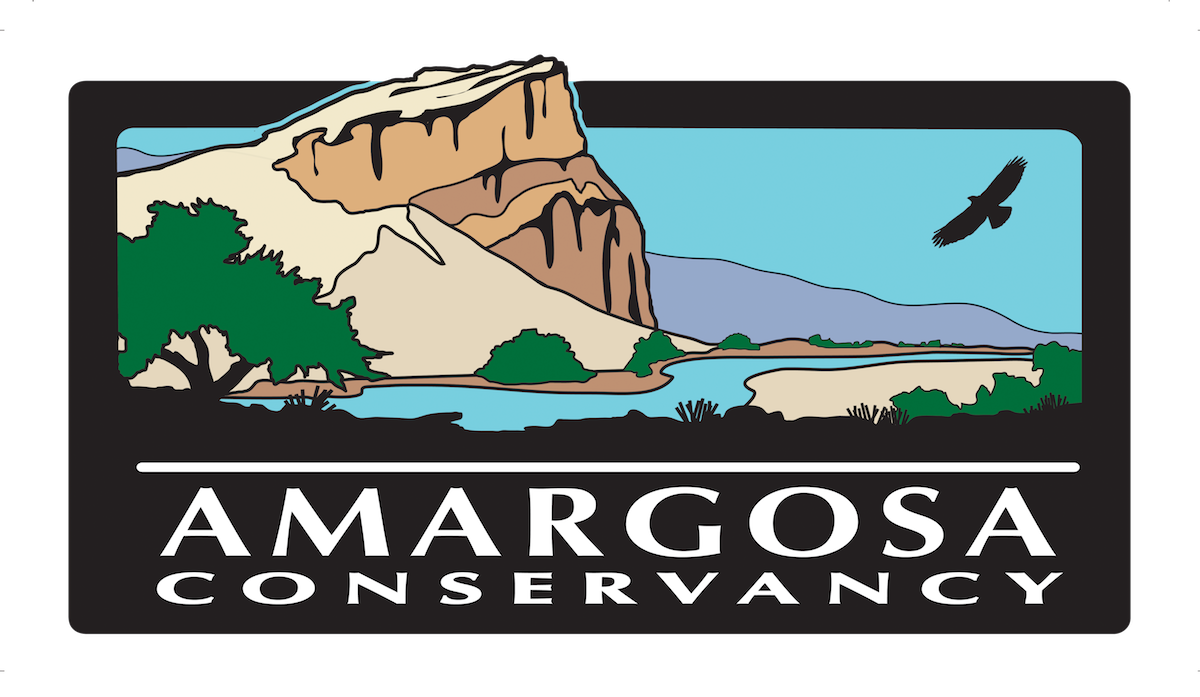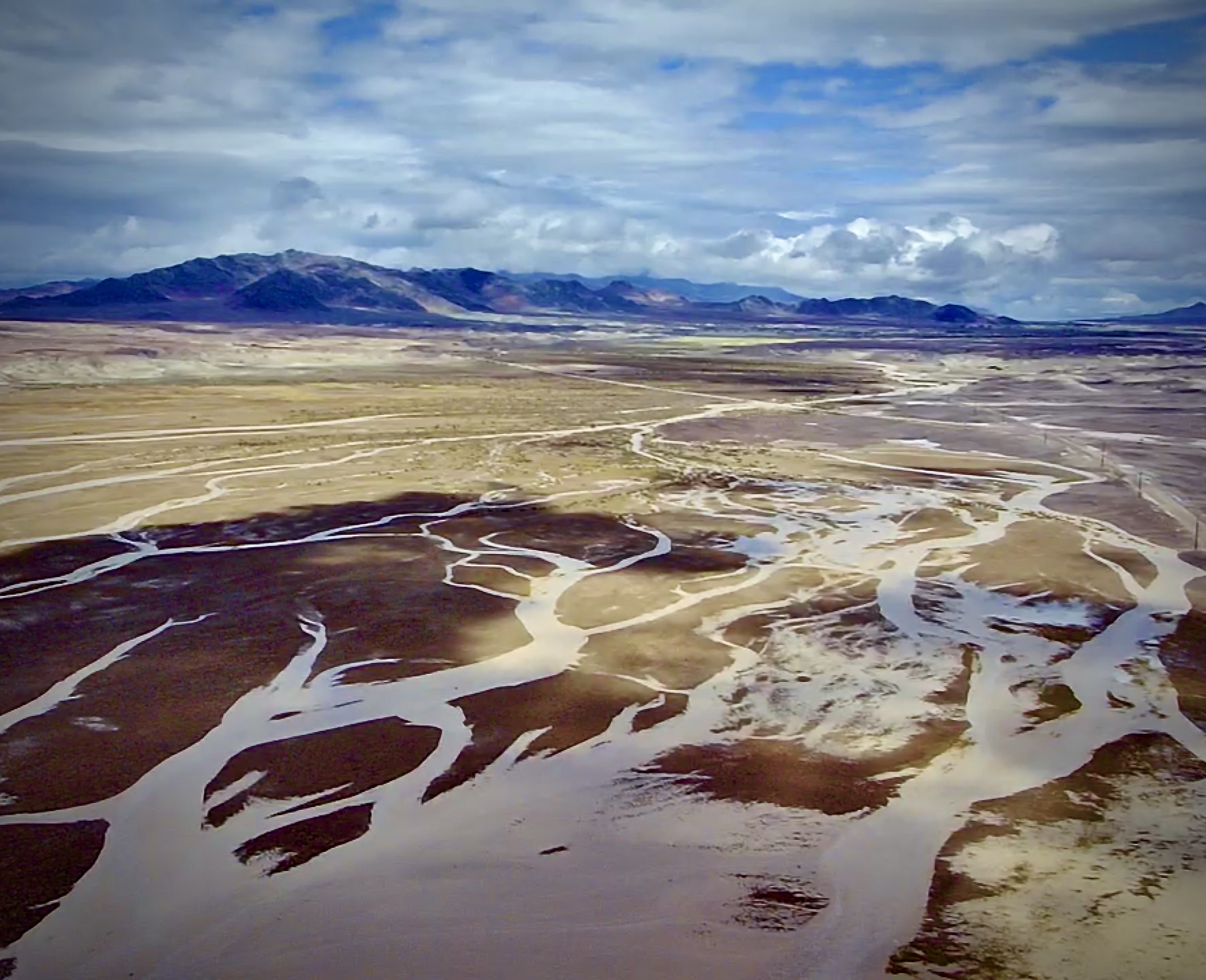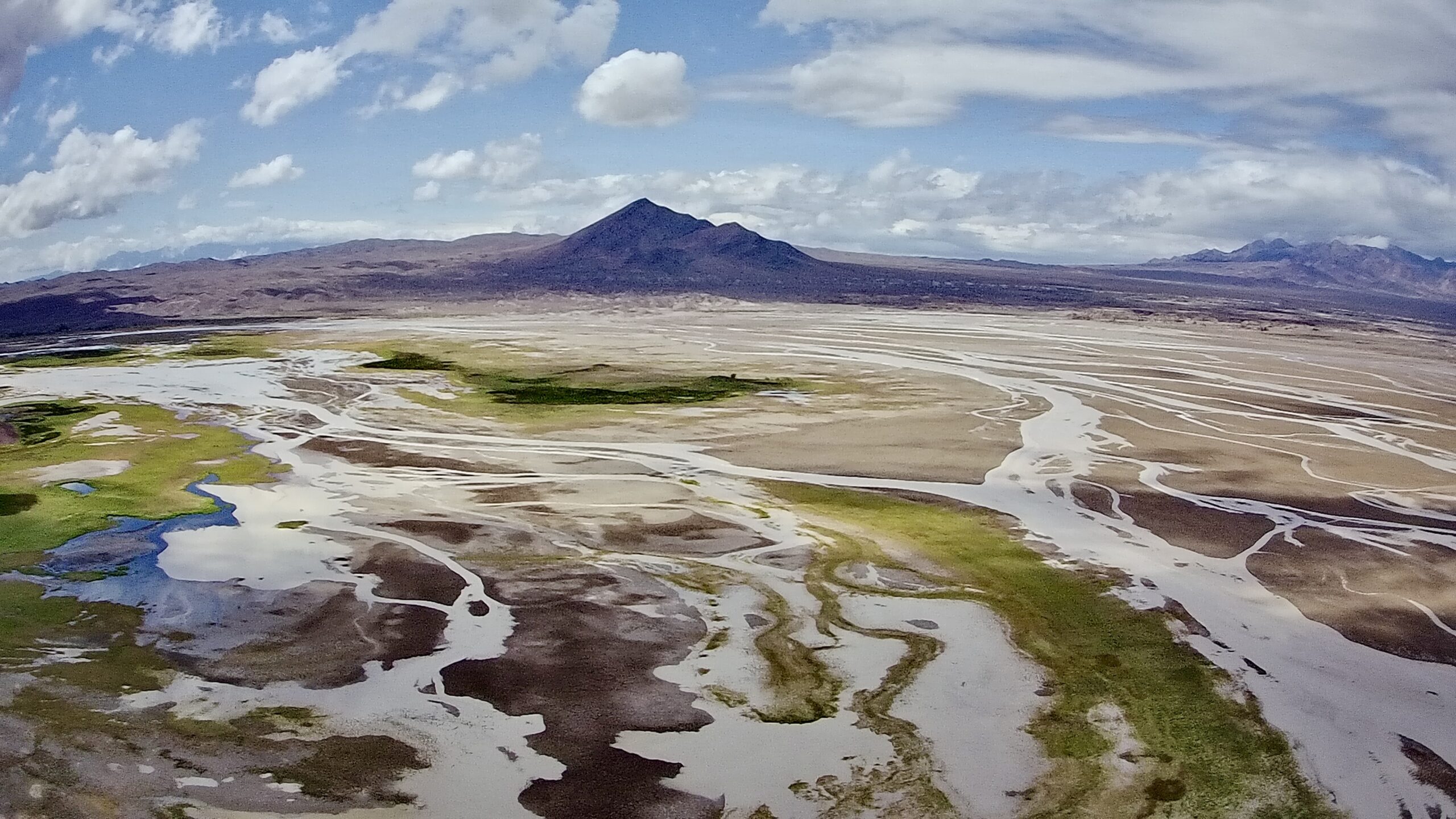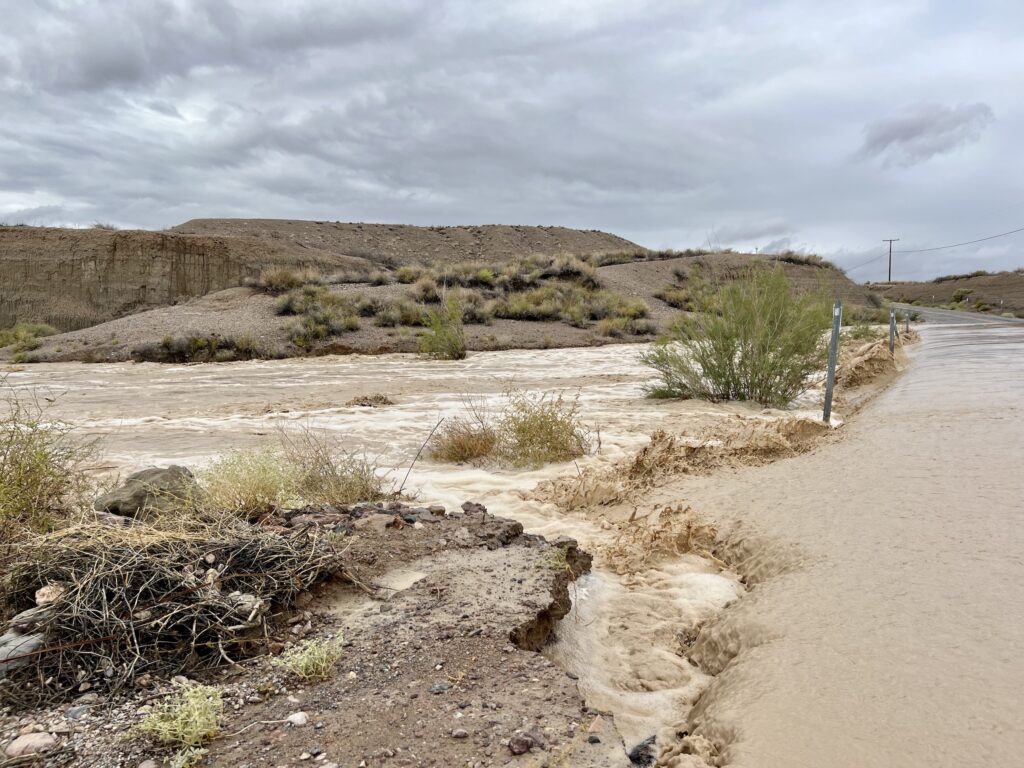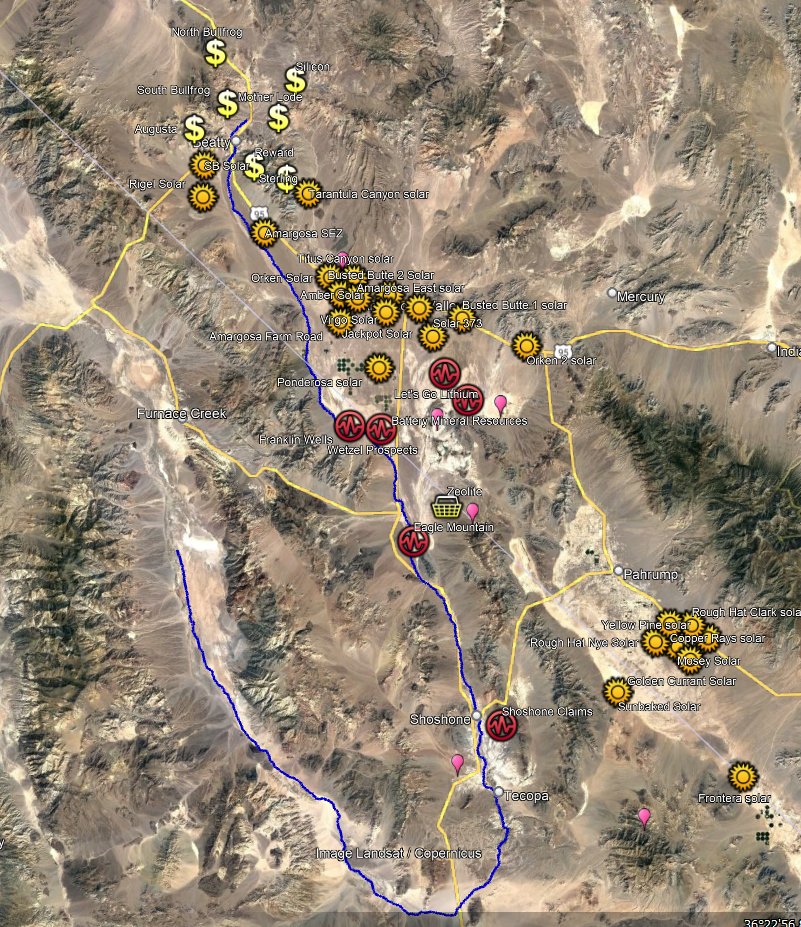Storms are blowing into the Amargosa Basin. Some are bringing water to the land, and others are seeking to take it away.
A hurricane in the desert
After one of the wettest winters in recent memory in parts of California, all hands were on deck bracing for Hurricane Hilary, the first hurricane to careen towards the California coast in 84 years. By the time it reached the arid lands of the eastern Mojave, Hilary still had enough juice to deposit several inches of rain over some areas in Death Valley and the Amargosa Basin in a 24-36 hour period. A couple of inches of rain in the desert is all it takes to produce floods of terrific force: terrific in this case connoting both feelings of terror and awe.
From a safe vantage point, it’s easy to get caught up in the reverie of such events. Watching the usually shy Amargosa River burst forth and flow in epic fashion is an experience that defies easy description. Such events are part of this ecosystem’s natural rhythm, and they show how these desert lands have been fundamentally shaped not only by the absence of water, but by an abundance of it. Floods are the most visceral reminders that the Amargosa is one river, an interconnected steady current of water coursing through the desert that every once in a blue moon shows itself for all to see.
But behind the reverie is a startling new reality. Flooding is starting to occur with much greater regularity in the Death Valley ecoregion. Death Valley National Park has closed yet again as they deal with the aftermath of floods that wiped out miles of roads in all areas of the park. Many reaches of the Mojave have scarcely had time to recover following the prodigious rains in August of 2022. Each massive rainfall event that has produced a “thousand year flood” over the last seven years has eroded and swept away with it any remaining faith in the idea that the world as we have understood it for centuries still remains. We are living in a new world now, in a new Mojave Desert and a new Amargosa Basin where chronic drought, raging wild fires, and scouring floods are part of the future climate regime. Folks that have lived on this land for decades, or who have inherited a memory of the land as it was before colonization, are seeing and feeling the changes with every passing season.
This new regime raises important questions and challenges for researchers, conservationists, and land managers regarding the resiliency of the ecosystem to events like flooding that are occurring more frequently and with greater intensity. How might more frequent strong floods impact Amargosa vole populations living in the Tecopa Marshes? What actions could be taken to slow down or mitigate the erosive force of these floods that hammer stream beds, roads, and trails? What restoration strategies could help bolster the resilience the multiple threatened and endangered species who depend on waters of the Amargosa River for their survival?
In light of these and other questions and challenges, the Amargosa Conservancy has convened a new Amargosa Restoration Working Group with the intention of better coordinating, designing, and implementing research and restoration projects in the California portion of the Amargosa Basin. This working group currently consists of researchers, state and federal agency staff, and nonprofit organizations actively involved in research and management of the Amargosa vole, Amargosa niterwort, Amargosa pupfish, least Bell’s vireo, and other significant species in the watershed. (Learn more about these species here). For the last two decades, the AC has been a member of collaborative working groups focusing on these key species. Without this collaboration, we would know a lot less about these species and their habitats, and frankly species like the Amargosa vole might not still be around. It has taken a literal village to keep many of the wildlife species that have always lived in a precarious existence from tipping over the brink into extinction. And if a hurricane coming to the Mojave Desert should tell us anything, it’s that our work as a conservation community to set up these species for future success is getting more challenging all the time.
We believe that enhanced collaboration in the planning and executing of restoration projects in the watershed is critical to understanding the changes happening in the landscape as a result of climate change and to better addressing the threats they present to life on the landscape. Our hope is that this newly formed Amargosa Restoration Working Group will enable us to better attend to the impacts of droughts, fires, and storms that are surely coming our way.
A different kind of storm brewing in Nevada
There is a storm of a different kind brewing on the Nevada side of the Amargosa River watershed. After a summer spent battling to save Ash Meadows National Wildlife Refuge from the specter of exploratory mining on its doorstep, we were able to take a much-needed breath following the BLM’s decision to rescind their approval of Rover Metal’s Let’s Go Lithium project and require the project to go through an environmental approval process. But according to recent news articles, the mining company is making moves to push the project forward, despite the public’s strong opposition to the project. We had hoped the science and the public’s stance on this matter were crystal clear enough to dissuade Rover Metals or any subsequent mining company from trying to conduct mining activities on the boundary of a wildlife refuge with one of the highest local concentrations of endemic species (species that live nowhere else) in North America. But as it stands, we are prepared to continue to lead the fight against this project that does not align with the interests of the communities or with the wellbeing of wildlife in the watershed. We’re gearing up for what will surely be a contentious National Environmental Policy Act (NEPA) review, and will be depending on our partners and supporters to help us engage robustly in the process.
But in truth, though Rover Metals’ drilling project poses the most direct threat to groundwater-dependent habitat and wildlife in this area, this project is just one thunderhead in a much greater storm system sweeping into the region. A slew of proposed projects ranging from mineral extraction, to renewable energy development, to the construction of massive transmission lines continue to pour into the Amargosa Desert and Pahrump Valley regions. There are at last count at least 30 proposed solar energy projects in the region, encompassing tens of thousands of acres of development on largely undisturbed public lands. South of Pahrump, a non-planned industrial solar sector is sprawling along both sides of the Old Spanish Trail highway, threatening the historic viewshed and thousands of acres of intact desert ecosystem. Other projects in the Amargosa Desert are waiting with bated breath for the Greenlink West transmission corridor that would run from Reno to Las Vegas to be built so that they have a line to tie into for their arrays. Taken as a whole, these projects are the components of a veritable storm, a storm with the potential to jeopardize the future of the Amargosa River by virtue of the one thing all of these projects require: water.
Our organization continues to champion the need for land managers to consider the cumulative impacts of all of these proposed projects in the watershed, rather than analyzing them individually. The question must be asked as to what scale of development the Amargosa River watershed can truly sustain given that these projects will require water for their construction, operation, and maintenance. The answer to that question should be used to guide an intelligent strategy for determining where and how many of these projects are appropriate and aligned with a vision for the landscape that leaves intact the essential groundwater flows and habitat areas that make this region an ecological marvel.
We are currently working alongside partners to develop proactive strategies that will better safeguard the waters, wildlands, and communities of the Amargosa Basin. The window in which we can affect change at the right level to ensure a sustainable future for the Amargosa River in Nevada is open, but it may be fast closing with the dark clouds of this storm of projects brewing on the horizon. If you would like to help us on this perilous road towards meaningful change, please consider supporting us this season through a donation. We’ll need the support of our members now more than ever if we are to save places like Ash Meadows from the threats it faces on all sides.
Click here to donate today, and thank you as always for sharing our love for the mighty Amargosa River.
Onward,
Mason Voehl
Executive Director
